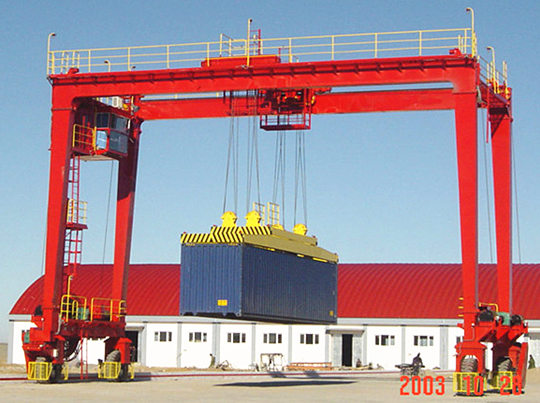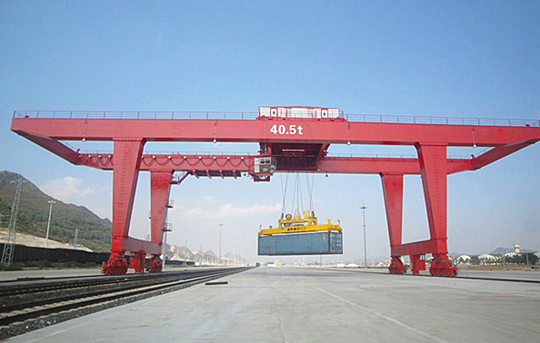Operating a container gantry crane is a complex task that demands a high level of skill, precision, and adherence to safety protocols. Container gantry crane is a kind of double beam gantry crane which have strong stability and high load capacity. These massive cranes play a critical role in efficiently transferring containers within ports and container yards, contributing to the global logistics network. From pre-operational checks to load positioning and post-operation maintenance, every step of the process requires careful execution. Here’s a comprehensive guide on how to operate a container gantry crane effectively and safely.

Pre-Operational Checks: Ensuring Readiness
Before you start operating a container gantry crane, conducting thorough pre-operational checks is essential to ensure the crane’s safety and functionality. Inspect the crane for visible damage, such as worn-out cables or loose bolts. Verify that the gantry tracks, trolley, and spreader are in optimal condition. Examine the crane’s lubrication points and confirm that they are adequately greased to prevent friction-related issues during operation. Additionally, check the surrounding area for any obstacles or personnel that might interfere with crane movement.
Familiarizing Yourself with the Controls: Navigating the Cabin
The cabin is the nerve center of the container gantry crane, where all operations are controlled. Before starting the crane, familiarize yourself with the control panel. Learn the functions of each lever, button, and switch, including those for gantry travel, trolley movement, hoisting, and spreader operation. Ensure that all controls are within easy reach and that you understand their roles in different crane movements.
Safety Checks: Prioritizing Operator and Load Safety
Container gantry cranes are equipped with multiple safety devices designed to prevent accidents. Verify that these safety features are operational before proceeding. Check the anti-collision system, which prevents collisions with other cranes and obstacles. Ensure that the limit switches are functioning correctly to prevent over-travel or over-lifting. Familiarize yourself with the emergency stop buttons and confirm that they are easily accessible from your position in the cabin.
Understanding the Load: Weight, Size, and Balance
Understanding the container’s weight, size, and balance is crucial for safe lifting and movement. Ask for the data of your crane from your crane manufacturer. Know the weight capacity of the crane and ensure that the container’s weight falls within this limit. Improperly balanced containers can tip over during lifting or placement, leading to accidents. Additionally, note the container’s dimensions and ensure that it fits the spreader properly.
Lifting the Load: A Delicate Procedure
Position the spreader over the container’s top and ensure that the twistlocks engage securely with the container’s corners. Start lifting the load with smooth and controlled acceleration to prevent swaying. Gradually increase the hoisting speed as the container clears the ground, maintaining steady upward movement.
Horizontal Movement: Guiding the Container
Container gantry cranes can move horizontally along the gantry tracks to position the load accurately. Coordinate the gantry travel with the trolley movement to ensure precise container positioning. Use the controls to align the container with the intended location, whether it’s a waiting truck, a stack of containers, or a specific spot on a ship.
Vertical Movement: Lowering the Load
Lower the container with controlled precision. Avoid sudden drops, as they can damage the container and create safety hazards. Slowly release the hoist control, allowing the container to descend smoothly until it safely lands in the designated position.
Trolley Movement: Adjusting the Container’s Position
The trolley’s lateral movement is used to adjust the container’s alignment. If needed, move the trolley to ensure that the container is placed accurately. Coordinate trolley movements with hoisting and gantry travel to prevent sudden shifts in load position.

Load Release: Ensuring Secure Placement
Once the container is securely positioned, release the twistlocks from the corners. Make sure that the spreader disengages smoothly from the container. Avoid sudden movements that could cause the container to tip or shift unexpectedly.
Post-Operation: Safety and Maintenance
After placing the container, engage the emergency stop and turn off the crane’s control system. Exit the cabin using designated access points. Report any anomalies or malfunctions observed during the operation to the maintenance team. Properly document the operation in the crane’s records.
Continuous Vigilance: Monitoring Throughout
Throughout the operation, remain vigilant about the load’s stability, weather conditions, and any signs of abnormal behavior. Address any deviations from normal operation promptly to prevent accidents or damage.
Operator Training and Certification: Safety First
Operating a container gantry crane requires proper training and certification. Ensure that operators are trained to handle emergency situations, follow safety protocols, and understand the crane’s intricate controls. Regular training and certification renewals are essential to maintain operational excellence and safety.
Maintenance and After-Operation Care: Prolonging Lifespan
Regular maintenance is essential to keep the container gantry crane in optimal condition. Address any wear and tear promptly and follow scheduled maintenance routines. Regular inspections, lubrication, and replacement of worn-out components are vital to ensuring safe and efficient crane operations.
Collaborating with the Team: Communication is Key
Effective communication with ground personnel, signalmen, and other team members is crucial during container gantry crane operations. Clear communication helps ensure that everyone is aware of the crane’s movements and the status of the load, reducing the risk of accidents. Ground personnel play a vital role in guiding the crane operator, especially when the operator’s view might be obstructed.
Signalmen stationed on the ground use standardized hand signals or radio communication to convey instructions to the crane operator. These signals indicate movements such as lifting, lowering, stopping, and traveling. Collaborating closely with the ground team allows for coordinated actions and enhances overall safety.
Regular communication helps operators stay informed about any changes in the operational environment, such as changing weather conditions, unexpected obstacles, or alterations in the intended container placement. By working together seamlessly, the entire team can ensure efficient and secure container handling operations.
In conclusion, effective communication and collaboration among the crane operator and ground personnel are essential components of safe and successful container gantry crane operations. This teamwork ensures that operations are conducted smoothly, minimizing risks and optimizing productivity.